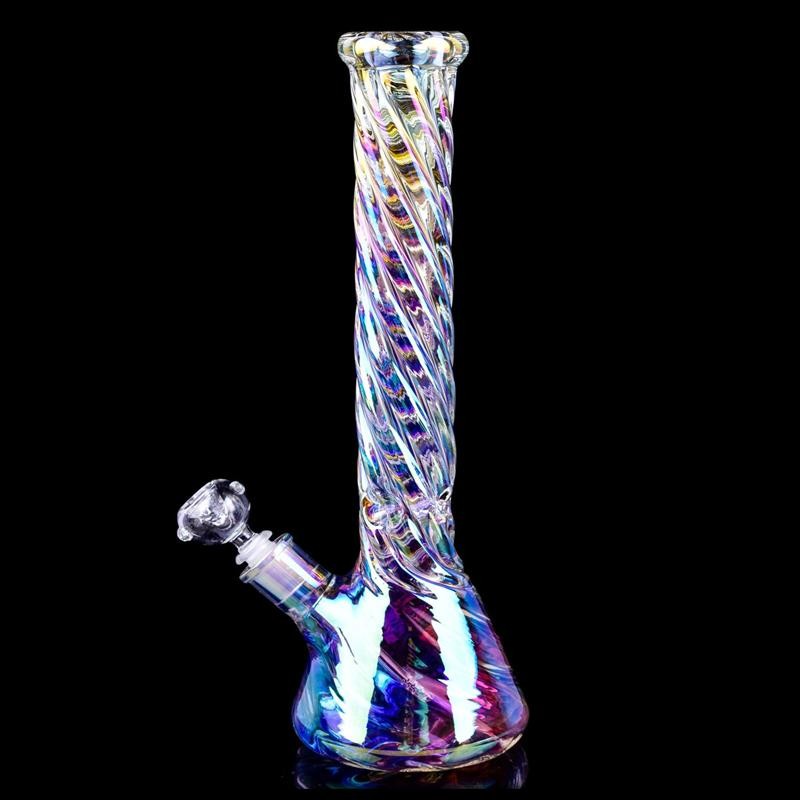
Honeycomb and Tree Bongs are some of the most popular pieces of glass when it comes to smoking. Both contain percolators which can bubble and filter your smoke.
But which is better - the tree percolator or the honeycomb percolator?
The Tree Bong

Tree bongs are composed of tree percolators, and just like their honeycomb counterparts, they have many holes that the smoke can diffuse through. Users enjoy tree percolator bongs both for the look and feel of the bong (tree percolation gives an interesting visual effect).
However tree percolators are not without issues.
Tree Percolator Bongs Can Clog
Tree percolators can have narrow pipes, which can clog quite easily. The amount of arms can very from 4 to 8, and they typically have 1-3 slits in each arm to help further diffuse the smoke. Unlike honeycomb percolators, however, these tiny arms can clog up quite a bit, which reduces the effectiveness of the entire percolator.
Tree Percolators Can Break More Easily
Unlike the honeycomb's sturdy structure, tree bongs can break more easily. The tiny arms of the the tree percolator can be delicate, as manufacture often times need to thin out the glass to make them fit. Depending on the quality of the glass, setting the bong down to hard, or shaking it too vigorously is all that it takes to break these tiny arms.
Smoke Takes the Path of Least Resistance
Even if all your tree percolator arms are clean and free of debris, your tree percolator might not be doing the job as well as you think.
Smoke takes the path of least resistance, and those arms that close to the water will allow more smoke through, which means if your water level is unbalanced, your percolator arms are not perfectly aligned, or if you like to tilt your bong when you smoke, you might have 3 of 6 arms actually working to filter your smoke.
Granted honeycomb bongs might suffer the same problem with the smoke only bubbling through half of all the honeycomb holes, which is why we must take a closer look at the honeycomb bong.
The Honeycomb Bong

The majestic honeycomb bong competes for the place of the tree percolator and we can see why.
Honeycomb Bongs Are Strong: Unlike the tree percolator, the structure of the honeycomb is naturally stronger, and your bong will be able to take a stronger beating
Honeycomb Bongs are easier to clean: Unlike the tree percolator, you dont have many tiny arms that need to be cleaned out.
Honeycomb Bongs are Visually Appealing: Just like the tree percolator, the honeycomb percolator provides nice visuals, which are pronounced when you stack more on top each other.
Honeycomb Bongs Might Also Suffer from Water Resistance: Unfortunately you might notice that not all honeycombs are bubbling as you take a drag. This is due to the natural tendency for that gasses to take the path of least resistance. While this might reduce the efficiency of the percolator, its probably not as much as you might get from a tree percolator.
Price: Honeycomb bongs are easier to manufacture so you might find better pricing with honeycomb bongs sold online.
So Which Bong is better?
Honeycomb bongs are more affordable, harder to break, easier to clean, hand have a great visual appeal.
Tree percolators are equally as visually appealing, but may break easier, are harder to clean, and have a higher price point.
While the honeycomb bong is superior in performance it also suffers the same performance issues, whereby not all honeycomb percolators may be working because smoke takes the path of least resistance (same with the tree percolator).
Honeycomb percolators are better, but not by much, as tree percolators are still great smoke diffusers. Good manufactures can overcome the slight disadvantages in the tree percolator by making the tree percolator arms thicker, and by making the arms of equal lengths, so that one arm isn't doing all the work.
When it is all said and done. Tree bongs vs Honeycomb bongs, and which is better? In the end it all comes down to personal preference :)

